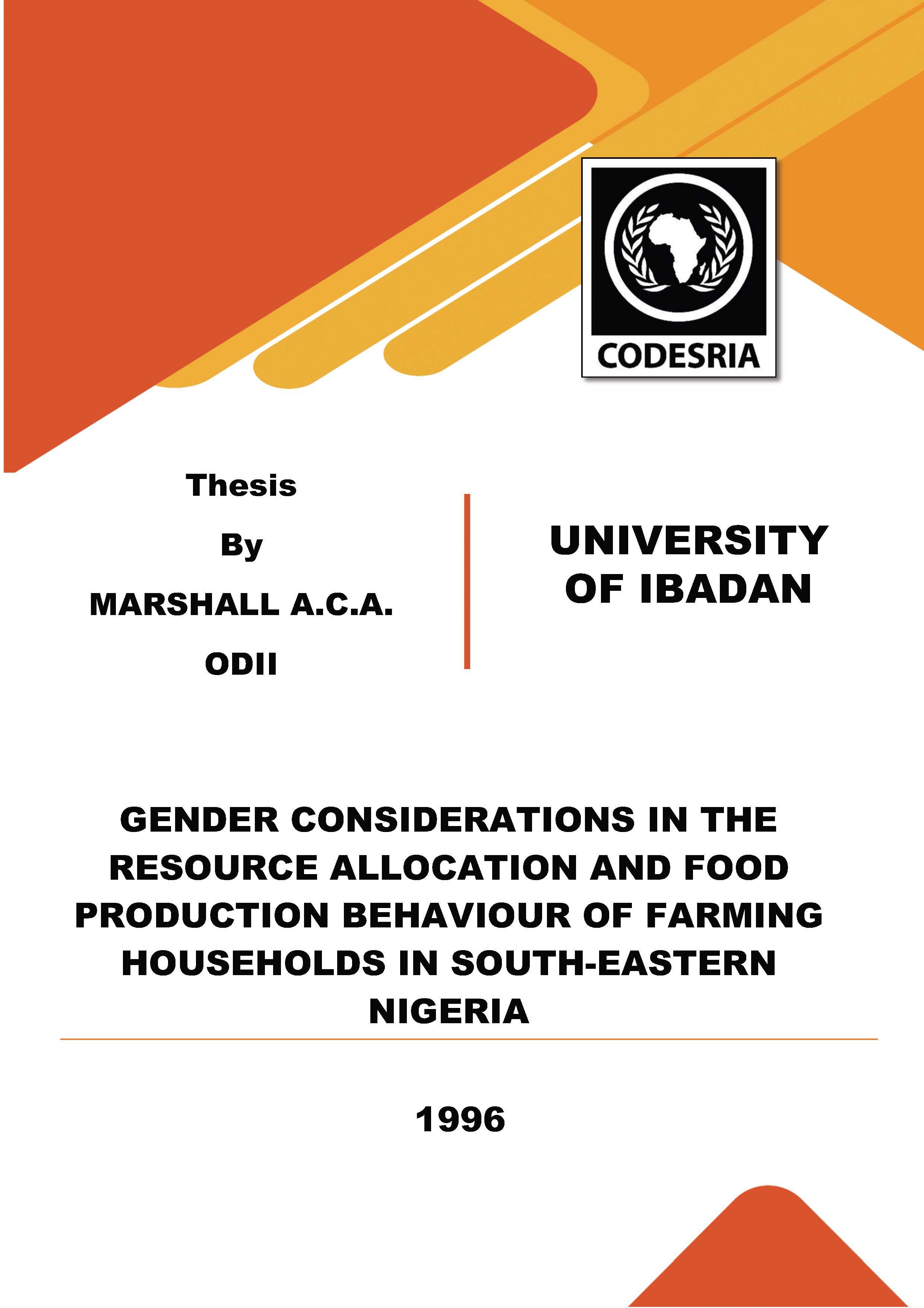GENDER CONSIDERATIONS IN THE RESOURCE ALLOCATION AND FOOD PRODUCTION BEHAVIOUR OF FARMING HOUSEHOLDS IN SOUTH-EASTERN NIGERIA
Mots-clés :
GENDER, RESOURCE ALLOCATION, FOOD, HOUSEHOLDS, SOUTH-EASTERN NIGERIASynopsis
The study analysed gender in relation to household resource allocation, food production or consumption as well as profit optimization behaviour in South-eastern Nigeria. The aim is to identify appropriate pattern of gender resource allocation that would simultaneously achieve food security and optimize farm returns at the house hold level.
Data on one hundred and fifty (150) farmers selected through a multi-stage random sampling procedure were analysed using a combination of statistics, econometrics and the normalized profit function. The major resources considered include labour, land, fertilizer, farrn credit and farm implements.
The results revealed that male farmers were older and hence more experienced than female farmers. Male members of the household generated more income from both farm and non-farm activities than the female members of the household.
Women farmers were predominantly engaged in food crop subsistence production mainly for household and little for the market while male farmers mainly engaged in the production of commercial crops, largely for the market and little for household food consumption. There was little or no di'2J.sion of labour in the performance of cultural practices. Thus agricultural activities are gender specific while cultural practices are hardly gender specific. In general, females spend more time than males in household agriculture.
Women depend purely on men in all matters concerning land negotiation. The male farmers cultivated larger hectarage than female farmers. This is probably because men had more access to all majority of the agricultural inputs studied than women. Men contributed significantly more than women in the purchases of both recurrent and capital items in the household, The magnitude, sign and the significance of the included gender variables shows that gender factors are important in,analysing household food consumption demand.
The marginal propensity to consume appear to be related more with changes in female farm output, male income, and size of male members of the household than for male farm output, female income, and size of female members of the household.
The magnitude, sign and the level of statistical significance of the included gender variables in the normalised profit function shows that gender factors are very important determinants of household farm profit particularly when resources are pooled together as in the joint farm normalized profit function. The normalized profit function for male and female farmers differed significantly statistically.
The demand equation for labour and tractor hire shows that male farmers are relatively more efficient in their use of both male and female hired labour as well as tractor hiring services than female farmers. There is no statistically significant gender difference in the relative efficiency of fertilizer use.
On the whole, male farmers are relatively technically and economically more efficient in allocation of farm inputs than female farmers in their farms. Both male and female farmers did not succeed in the same degree in profit maximizations. In fact, the test of absolute price efficiency shows that male farmers maximized profit while female farmers did not maximize profit.
Problems such as high cost of farm inputs, scarcity of farm inputs, inadequate funds for purchasing farm inputs, frequent changes in government policies, corruption among government officials were identified as major obstacles in input acquisition in the household. However, interest rate liberalization, subsidies, use of cooperatives, application of the provisions of the
Land Use Decree, use of ask Forces, development of appropriate technologies and overall reduction in input prices were suggested by the farmers studied as measures that could alleviate the problem of inadequate farm input acquisition at
the household level.
Generally adequate food production,cpnsumption and profit optimization would only take place at the household level if male and female issues concerning resource allocation are not treated in isolation. Thts is because their activities at the household level are rather complementary than competitive allocation, A holistic approach in resource job specification at the household
level would improve the nutrition, and hence welfare of the household members. This is because there would be a balance between food consumption, and profit maximizing goals as shown in the behaviour of the gender variables for the joint
farm normalized profit function.
Téléchargements
Références
Boserup, E. (1970), "Women's Role in Economic Development"London and Baltimore, Allen and Urivin Free Press
Bullow, D.V. (1991), "Reconsidering Female Subordination: Kipsigis Women in Kenya." Centre for Development Research Project Paper 91.2 5.
Bullow, D.V. and Sorenson, A. (1988), "Gender Dynamics in Contract Farming: Women's Role in Small-holder Tea Production in Kericho District, Kenya". Centre for Development Research, Denmark. pp. 28-63,167-198.
Buvinic, M. (1983), "Women's Issues in Third World Poverty: A Policy Analysis." In: Buvinigm Iycette, M.A. and McGreevy, W.P." (eds), Women and Poverty in the Third World, Baltimore MD: John Hopkins
uhiversity Press pp. 13 - 33.
Cain, G. (1967) "Unemployment and Labour Force Participation of Secondary Workers" Industrial and Labour Relations Review Vol.20 No.2 PP 275 - 277
Cain, G.G. (1960), "Married Women in the Labour Force: An Economic Analysis." Chicago, United States of America.
Chand, R. and J.L. Kaul (1986), "A Note on the Use of the Cobb Douglas Profit Function." American Journal of Agric.Econs. 68(1): 162 - 164.
Chavagi, N.A. and A. Hansen (1983), "Women in Livestock Production'with Particular Reference to Dairying." Food and Agricultural Organisation, Rome.






